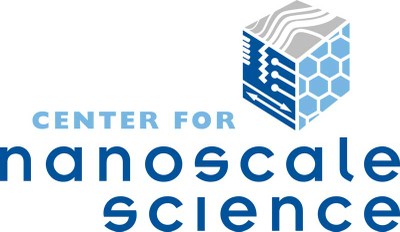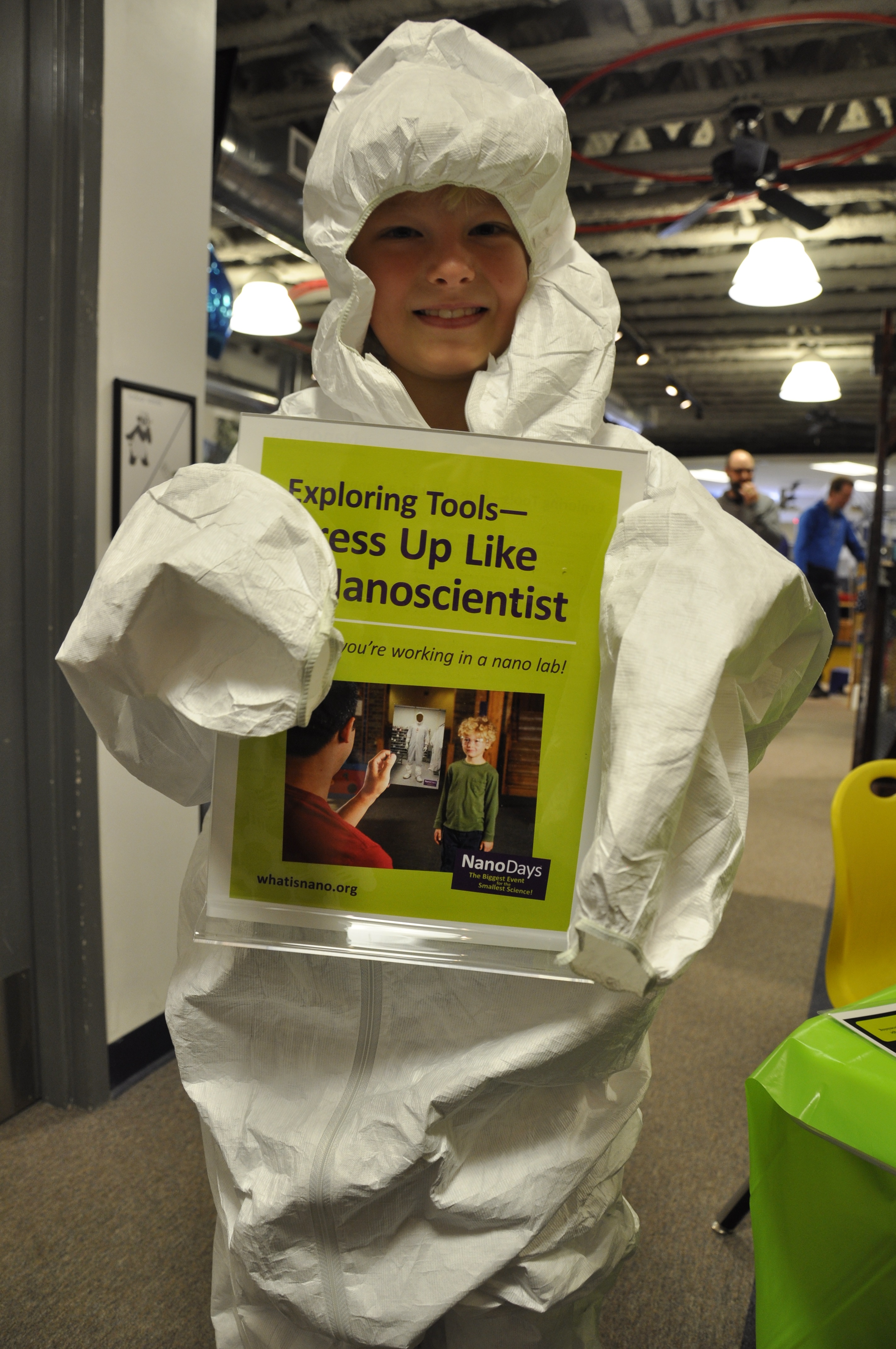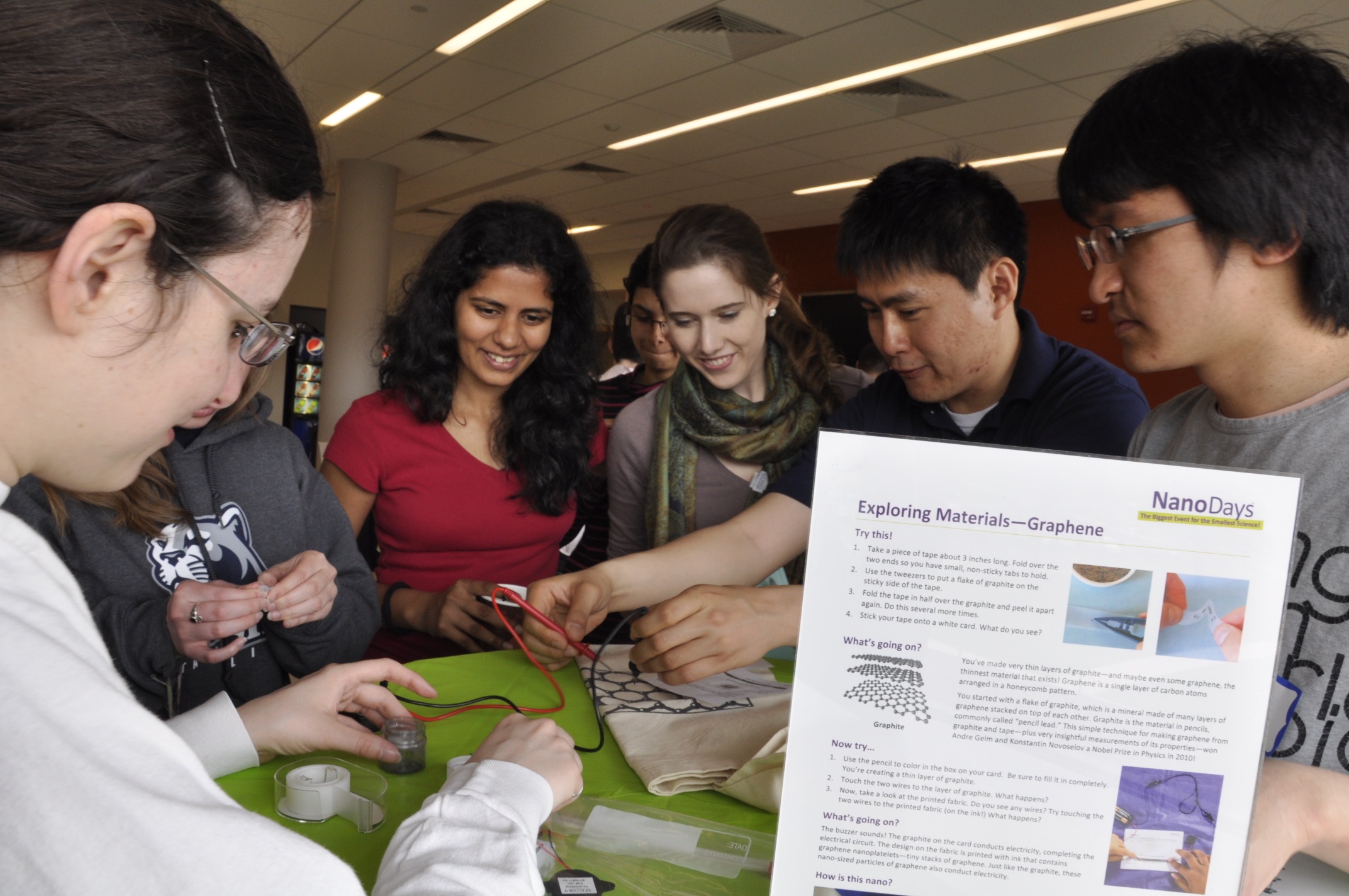 In her position as Program Director for Education and Outreach at Penn State University’s Center for Nanoscale Science, Kristin Dreyer’s initiatives reach a wide range of audiences. For NanoDays 2015, she planned three different events. First, she coordinated a partnership with a local museum, Discovery Space of Central PA, to host a festival-style NanoDays event targeting families with children. Next, she took advantage of a weekly café, designed to promote interdisciplinary research collaborations at Penn State, to talk to her colleagues about out reach opportunities using the NanoDays kits. Finally, in collaboration with Penn State’s Center for Science and the Schools (CSATS) and several other university partners, she organized a workshop for grade 6-12 teachers to build knowledge about nanoscience and design learning activities that model scientific research skills.
In her position as Program Director for Education and Outreach at Penn State University’s Center for Nanoscale Science, Kristin Dreyer’s initiatives reach a wide range of audiences. For NanoDays 2015, she planned three different events. First, she coordinated a partnership with a local museum, Discovery Space of Central PA, to host a festival-style NanoDays event targeting families with children. Next, she took advantage of a weekly café, designed to promote interdisciplinary research collaborations at Penn State, to talk to her colleagues about out reach opportunities using the NanoDays kits. Finally, in collaboration with Penn State’s Center for Science and the Schools (CSATS) and several other university partners, she organized a workshop for grade 6-12 teachers to build knowledge about nanoscience and design learning activities that model scientific research skills.
Like many NISE Net partners, Kristin and her team enjoy the flexibility of the NanoDays kits to mix and match activities into a cohesive theme. This year, for the teacher workshop, CSATS research associate Matt Johnson worked with entomologist Dr. Mike Domingue to focus on a theme of particular local importance—the invasive emerald ash borer that is threatening Pennsylvania forests. To detect and trap these beetles, Mike has led an innovative research effort to develop nanofabricated, electroconductive decoys that replicate the beetle’s wing nanostructures and successfully attract, stun, and kill the insects for collection.
 During the workshop, a collection of past and present NanoDays activities were used to guide teachers in hands-on learning about this research story. The blue morpho butterfly activity demonstrated how color can emerge from nanostructures on an insect wing. Other optical properties of materials were illustrated using polarizers, thin films, stained glass, and nanogold, while graphene demonstrated principles of conductivity. Teachers used the transmission electron microscope model as well as Matt’s own model of an atomic force microscope to learn about the instrumentation used for characterization, then got a tour of Penn State’s characterization and nanofabrication facilities to see the real instruments in action. Images of the beetle and decoy were later viewed remotely—a unique opportunity for teachers and their students to use and control powerful microscopes from their classrooms.
During the workshop, a collection of past and present NanoDays activities were used to guide teachers in hands-on learning about this research story. The blue morpho butterfly activity demonstrated how color can emerge from nanostructures on an insect wing. Other optical properties of materials were illustrated using polarizers, thin films, stained glass, and nanogold, while graphene demonstrated principles of conductivity. Teachers used the transmission electron microscope model as well as Matt’s own model of an atomic force microscope to learn about the instrumentation used for characterization, then got a tour of Penn State’s characterization and nanofabrication facilities to see the real instruments in action. Images of the beetle and decoy were later viewed remotely—a unique opportunity for teachers and their students to use and control powerful microscopes from their classrooms.
 In addition to planning the details of each event, Kristin also considers how to leverage the intersection of these events to achieve more "big-picture" broader impact goals. One strategy was to recruit graduate student volunteers who could commit to participating in all three events. At Discovery Space, they worked in teams with pre-service elementary education teachers and school-aged volunteers to prepare and present NanoDays activities, each contributing a unique perspective that benefited fellow team members. Diving deeper into the NanoDays activities and related content with teachers at the workshop, graduate volunteers were able to share their own experiences doing real scientific research. When demonstrating the activities to peers at the research café, they also offered valuable testimonials about their outreach work. Before and after each event, Kristin worked with them to reflect and shift focus to the needs and interests of the next target group. Thanks to this thoughtful approach, student volunteers developed flexible communication skills and realized the value of adapting the same activity to diverse audiences. In addition to the professional development benefits gained by engaging in public outreach, the graduate students found that these experiences renewed their own inspiration for science, and they cherished the opportunity to be role models for the next generation of scientists.
In addition to planning the details of each event, Kristin also considers how to leverage the intersection of these events to achieve more "big-picture" broader impact goals. One strategy was to recruit graduate student volunteers who could commit to participating in all three events. At Discovery Space, they worked in teams with pre-service elementary education teachers and school-aged volunteers to prepare and present NanoDays activities, each contributing a unique perspective that benefited fellow team members. Diving deeper into the NanoDays activities and related content with teachers at the workshop, graduate volunteers were able to share their own experiences doing real scientific research. When demonstrating the activities to peers at the research café, they also offered valuable testimonials about their outreach work. Before and after each event, Kristin worked with them to reflect and shift focus to the needs and interests of the next target group. Thanks to this thoughtful approach, student volunteers developed flexible communication skills and realized the value of adapting the same activity to diverse audiences. In addition to the professional development benefits gained by engaging in public outreach, the graduate students found that these experiences renewed their own inspiration for science, and they cherished the opportunity to be role models for the next generation of scientists.
To learn more about NISE Net partner, Penn State University's Center for Nanoscale Science, visit https://www.mrsec.psu.edu/ or contact the NISE Net's Mid-Atlantic Regional Hub Leader.
NISE Net NanoDays activities mentioned in partner highlight include:
- Exploring Structures - Butterfly (NanoDays 2012)
- Exploring Materials - Polarizers
- Exploring Materials - Thin Films
- Exploring Materials - Stained-Glass Windows
- Exploring Materials - Nano Gold (NanoDays 2012)
- Exploring Materials - Graphene
- Exploring Tools - Transmission Electron Microscopes
